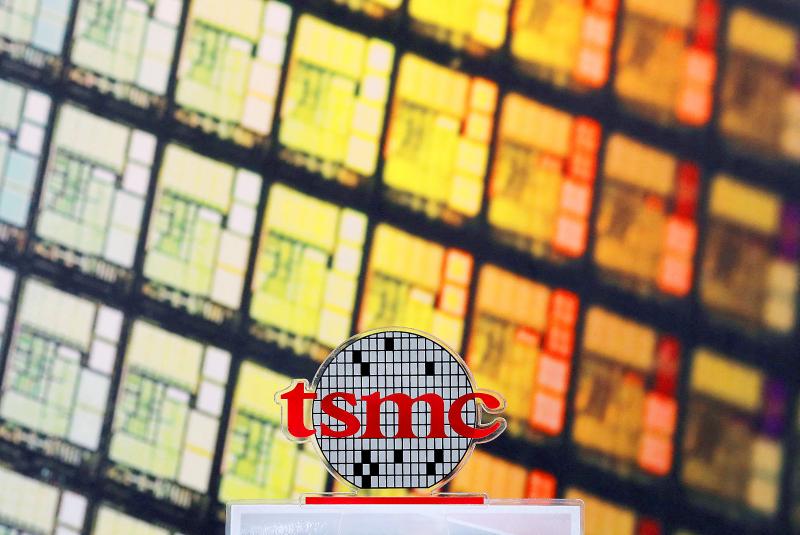Taiwan Semiconductor Manufacturing Co (TSMC, 台積電) executives on Thursday said that it would obtain the next version of ASML Holding NV’s most advanced chipmaking tool in 2024.
The tool — called “high-NA EUV” — produces beams of focused light that create the microscopic circuitry on computer chips used in phones, laptops, vehicles and artificial intelligence devices, such as smart speakers.
EUV stands for extreme ultraviolet, the wavelength of light used by ASML’s most advanced machines.

Photo: Tyrone Siu, Reuters
“TSMC will bring in high-NA EUV scanners in 2024 to develop the associated infrastructure and patterning solution needed for customers to fuel innovation,” TSMC senior vice president of research and development Y.J. Mii (米玉傑) said at the company’s technology symposium in Silicon Valley.
MASS PRODUCTION
Mii did not say when the device, the second generation of extreme ultraviolet lithography tools for making smaller and faster chips, would be used for mass production.
TSMC rival Intel Corp has said it would use the machines in production by 2025 and that it would be the first to receive the machine.
As Intel enters the business of making chips that other companies design, it would be competing with TSMC for those customers.
TSMC senior vice president of business development Kevin Zhang (張曉強) clarified that TSMC would not be ready for production with the new high-NA EUV tool in 2024, but that it would be used mostly for research with partners.
“The importance of TSMC having it in 2024 means they get to the most advanced technology faster,” said TechInsights chip economist Dan Hutcheson, who was at the symposium.
“High-NA EUV is the next major innovation in the technology that will put the chip technology at the lead,” Hutcheson said.
NANOSHEET
TSMC also gave more details on the technology for its 2-nanometer chips, which it said are on track for volume production in 2025.
TSMC said it has spent 15 years developing so-called “nanosheet” transistor technology to improve speed and power efficiency, and will use it for the first time in its 2-nanometer chips.

Shiina Ito has had fewer Chinese customers at her Tokyo jewelry shop since Beijing issued a travel warning in the wake of a diplomatic spat, but she said she was not concerned. A souring of Tokyo-Beijing relations this month, following remarks by Japanese Prime Minister Sanae Takaichi about Taiwan, has fueled concerns about the impact on the ritzy boutiques, noodle joints and hotels where holidaymakers spend their cash. However, businesses in Tokyo largely shrugged off any anxiety. “Since there are fewer Chinese customers, it’s become a bit easier for Japanese shoppers to visit, so our sales haven’t really dropped,” Ito

The number of Taiwanese working in the US rose to a record high of 137,000 last year, driven largely by Taiwan Semiconductor Manufacturing Co’s (TSMC, 台積電) rapid overseas expansion, according to government data released yesterday. A total of 666,000 Taiwanese nationals were employed abroad last year, an increase of 45,000 from 2023 and the highest level since the COVID-19 pandemic, data from the Directorate-General of Budget, Accounting and Statistics (DGBAS) showed. Overseas employment had steadily increased between 2009 and 2019, peaking at 739,000, before plunging to 319,000 in 2021 amid US-China trade tensions, global supply chain shifts, reshoring by Taiwanese companies and

Taiwan Semiconductor Manufacturing Co (TSMC, 台積電) received about NT$147 billion (US$4.71 billion) in subsidies from the US, Japanese, German and Chinese governments over the past two years for its global expansion. Financial data compiled by the world’s largest contract chipmaker showed the company secured NT$4.77 billion in subsidies from the governments in the third quarter, bringing the total for the first three quarters of the year to about NT$71.9 billion. Along with the NT$75.16 billion in financial aid TSMC received last year, the chipmaker obtained NT$147 billion in subsidies in almost two years, the data showed. The subsidies received by its subsidiaries —

Taiwan Semiconductor Manufacturing Co (TSMC) Chairman C.C. Wei (魏哲家) and the company’s former chairman, Mark Liu (劉德音), both received the Robert N. Noyce Award -- the semiconductor industry’s highest honor -- in San Jose, California, on Thursday (local time). Speaking at the award event, Liu, who retired last year, expressed gratitude to his wife, his dissertation advisor at the University of California, Berkeley, his supervisors at AT&T Bell Laboratories -- where he worked on optical fiber communication systems before joining TSMC, TSMC partners, and industry colleagues. Liu said that working alongside TSMC